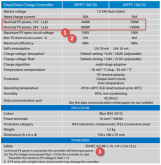I learned something interesting about Victron Solar Charge Controllers (SCC) the other day.
Most SCCs on the market provide two important specifications: Maximum PV Voltage and Maximum PV Power, and you can use these to correctly size your SCC to your PV array. Victron SCCs do not follow this trend, they instead provide a Maximum PV Voltage and a Nominal PV Power, for example, here's the specifications for the Victron SmartSolar 100|30/50:

Note the Nominal PV Power, this is basically the minimum PV power required to generate a 30A/50A charge current e.g. 14.6V x 30A = 438W or 14.6V x 50A = 730W etc.
The Maximum PV Power the unit can handle is actually defined by PV Voc (1) and PV Isc (2) i.e. 100V x 35A = 3,500W (100|30) or 100V x 60A = 6,000W (100|50).
And as you can see from note (3), the unit will simply limit input power if the array is more than 440W/700W etc.
So in theory, you could connect a 3,500W PV array to the Victron 100/30 and, whilst you would obviously be leaving 3,060W on the table (!), it would still be operating within specifications (obviously assuming 100V Voc or 35A Isc isn't exceeded).
Clearly, Victron SCCs have been designed with over-panelling in mind, in fact, the chap I spoke to at Victron about this actually recommended 30% over-panelling to optimise output on cloudy days.
Most SCCs on the market provide two important specifications: Maximum PV Voltage and Maximum PV Power, and you can use these to correctly size your SCC to your PV array. Victron SCCs do not follow this trend, they instead provide a Maximum PV Voltage and a Nominal PV Power, for example, here's the specifications for the Victron SmartSolar 100|30/50:

Note the Nominal PV Power, this is basically the minimum PV power required to generate a 30A/50A charge current e.g. 14.6V x 30A = 438W or 14.6V x 50A = 730W etc.
The Maximum PV Power the unit can handle is actually defined by PV Voc (1) and PV Isc (2) i.e. 100V x 35A = 3,500W (100|30) or 100V x 60A = 6,000W (100|50).
And as you can see from note (3), the unit will simply limit input power if the array is more than 440W/700W etc.
So in theory, you could connect a 3,500W PV array to the Victron 100/30 and, whilst you would obviously be leaving 3,060W on the table (!), it would still be operating within specifications (obviously assuming 100V Voc or 35A Isc isn't exceeded).
Clearly, Victron SCCs have been designed with over-panelling in mind, in fact, the chap I spoke to at Victron about this actually recommended 30% over-panelling to optimise output on cloudy days.


